Source:
By Kate Aldrich, eHow Contributor
updated: August 21, 2009
i hope you learn more about ginger. this blog will serve you as a guide on how to plant red ginger..
enjoy reading my blog...
I want to do this! What's This?
Red ginger plants are prized for their shiny, green leaves and white flowers with stunning red bracts, which look beautiful in flower arrangements. Planting red ginger root cuttings is the easiest way to grow your own red ginger plant ... short of buying an actual plant, of course. The red ginger plant loves heat and humidity, so if you don't live in hardiness zone 11, be sure to keep your red ginger in a greenhouse.
Difficulty: Moderately Easy
Instructions
Things You'll Need:
* Red ginger plant root cutting
* Planter (if not planting in the ground)
* Loam (sandy or clay)
* Water-soluble fertilizer
1.prepare your red ginger root cutting for planting by loosening the roots so they're not intertwined with each other.
2.Fill your planter with loam; anything from sandy to clay is fine for red ginger. If you're planting right in the ground, add a top layer of loam.
3.Plant the root cutting two inches below the surface of the soil. It's OK if the green growth is above the soil line.
4.Use a water-soluble fertilizer immediately after planting and repeat every two weeks during the growing season (approximately March to September).
5.Water your newly planted red ginger root cutting generously. Soak the soil with each watering and water again when the soil feels dry to the touch an inch deep.
Tips & Warnings
*
If you test your soil pH, aim for a pH between 6 and 7.5 for red ginger. Red ginger plants are heat and humidity lovers, but they prefer partial shade (such as that provided by tree leaves growing overhead).
Read more: How to Plant a Red Ginger Plant From a Root Cutting | eHow.com http://www.ehow.com/how_5026953_plant-ginger-plant-root-cutting.html#ixzz0zkGoSbQh
Thursday, September 16, 2010
Monday, September 13, 2010
Ginger
| Other scientific names | Common names |
| Amomum zingiber Linn. | Agat (Pamp., Pang.) |
| Zingiber blancoi Hassk. | Baseng (Ilk.) |
| Gengibre (Span.) | |
| Laial (Sbl.) | |
| Laiya (If.) | |
| Laya (Ilk., Bon., Ibn., It.) | |
| Luy-a (Bis.) | |
| Luya (Tag.) | |
| Chiang-t'i (Chin.) | |
| Ginger (Engl.) |
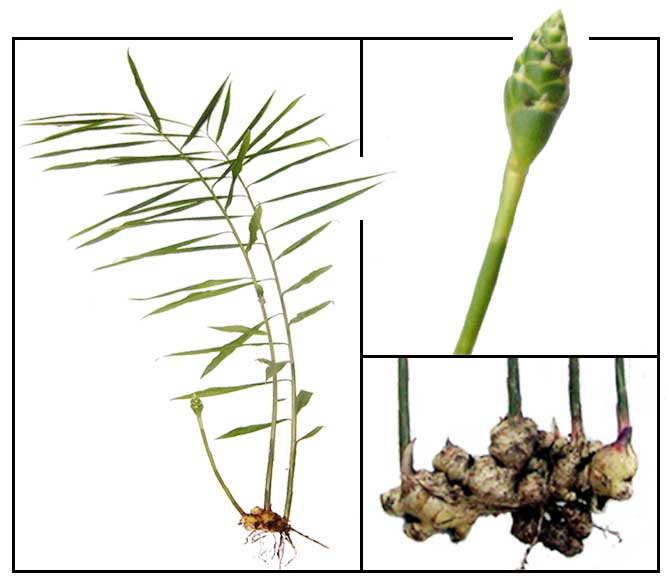
| Botany Erect, smooth plant with thickened and aromatic rootstocks. Leafy stems are 0.4 to 1 meter high. Leaves are distichous, lanceolate to linear-lanceolate, 15-25 cm long, and 2 cm wide or less. Scape from rootstock is erect, 15-25 cm high, covered with imbricate bracts. Calyx is 1 cm long. Corolla is greenish-yellow with a tube less than 2 cm long. 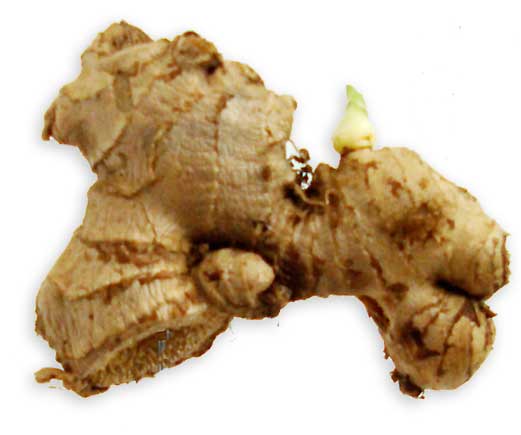 Distribution DistributionWidely cultivated in the Philippines. Parts utilized Tops, leaves and edible roots. Constituents • Pungent principles, mainly zingerone and shogaol, provides the characteristic taste. • The most biologically active phenolic compounds, gingerols and shogaols, are found in the root. • Volatile oil, 1.23 to 3% - gingerol, zingerone, zingiberene, cineol, borneol, phellandrene, citral, zingiberene, linalool, geraniol, chavicol, vanillyl alcohol, camphene; resin. Properties • Extracts and active constituents have shown potent antioxidant, antiinflammatory, antimutagenic, antimicrobial and possible anticancer activities. • Considered adaptogenic, anodyne, anthelmintic, antiallergenic, antibacterial, anticoagulant, anticonvulsant, antidepressant, antifungal, antithrombotic, antitumore, antiulcer, aphrodisiac, carminative, diuretic, rubifacient, anti-platelet aggregation, hypolipidemic, thermoregulatory. Uses Nutritional Flavoring for ginger ale, ginger beer, and other beverages. Salabat, a native beverage, is prepared from the rhizomes. A prominent condiment in Filipino cuisine. Taken with rocksalt before meals is cleansing to the tongue and throat and increases the appetite. Folkloric Antiseptic: Prepare tincture of dried rhizome with 70% alcohol (not rubbing alchol) and apply on superficial cuts and wounds or use juice from fresh rhizome. As digestive aid and for flatulence and tympanism: Take decoction of the rhizome as tea. Rheumatism: Pound roasted rhizome, mix with oil and apply locally. Sore throat and hoarseness : Take warm decoction of the rhizome as ginger tea (salabat) or chew a small piece of rhizome. Cough remedy and carminative. Diuretic. Hangovers. Headaches: Ginger plaster (bruised ginger in water to the consistency of poultice) applied to the forehead. Same preparation may be helpful for toothaches and facial pain. In Ayurvedic medicine, used for inflammation and rheumatism. In Chinese folk medicine, pulverized fresh ginger used for baldness and vitiligo. Juice from fresh root used for treatment of burns. New uses • Motion Sickness / Pregnancy-related Nausea: Antiemetic properties. Used for Nausea, motion sickenss (1 gm taken 1/2 hour before the voyage). Stimulates digestion. Possibly antiinflammatory. Preparations • Ginger tea Ginger tea preparation, the Chinese way : Bring one cup of water to boil. Add one teaspoon of the roasted (parched and browned) rice and a small piece of ginger root. Boil for one minute. Let stand to cool for drinking. (Preparation of dried rice: Pour enough water to cover 1/2 cup white rice in a flat dish; and let stand overnight. In the morning, drain off the excess water. Roast the rice in a dry pan, stirring constantly until parched and brown. Store in a glass jar for future use, tightly covered to keep moisture out.) • Ginger lozenges • Wash and peel the ginger, then mince. • Spread and air-dry for a day or oven-dry at 250 C. • Grind and strain the dried ginger. * In a mortar, mix 1 cup ground giner and 1 cup confectioner's sugar. • Pound and mix while gradually adding water until a pulp is formed. • Level the pulp on a board lined with wax paper. • Using a mold, make balls from the pulp and wrap each lozenge in aluminum foil. How to make medicated candies from powdered rhizomes Materialls, proportion and procedure Go to Traditional and Modern Medicine http://traditionalmed.blogspot.com/2007/01/how-to-prepare-ginger-lozenges.html Studies • Prokinetic: Pharmacological basis for the medicinal use of ginger in gastrointestinal disorders: Study confirmed prokinetic activity of the extract. Spasmolytic constituents may explain its use in hyperactive states as in colic and diarrhea. • Antidiarrheal: Study results indicate that in the absence of antimicrobial action, Z officinale exhibits its antidiarrheal activity by affecting bacterial and host cell metabolism. • Antibacterial: Antibacterial Activity Of Allium cepa (Onions) And Zingiber officinale (Ginger) On Staphylococcus aureus And Pseudomonas aeruginosa Isolated From High Vaginal Swab: Thes study showed both plant had antibacterial activity on the test organisms, ginger having more inhibitory effect, and confirming their folkloric use. • Antiinflammtory / Anti-thrombotic: The use of ginger (Zingiber officinale Rosc.) as a potential anti-inflammatory and antithrombotic agent: Study suggests ginger can be used as a cholesterol-lowering, anti-thrombotic and anti-inflammatory agent. • Antioxidant / Anticancer: Study showed Zingiber officinale may exert its anticancer effect by replacing the action of superoxide dismutase, glutathione peroxidase and catalase in removing superoxide radicals and hydrogen peroxide causing oxidative damage to cells. • Antibacterial (Garlic/Ginger) Synergism: Study investigated the therapeutic effects of ginger and garlic against Klebsiella pneumonia, whether the combined extract could be synergistic or antagonistic in rats. Study showed a synergistic relationship, garlic ameliorating the efficacy of giner only against Klebsiella infection. • Anti-Inflammatory / Anti-Arthritis / Prostaglandin Inhibition: Study suggests one of the mechanisms by which ginger shows ameliorative effects could be through inhibition of prostaglandin and leukotrine biosynthesis - as a dual inhibitor of eicosanoid biosynthesis. • Gastroprotective: Study results suggest cytoprotective and anti-ulcerogenic effects with significant protection against ethanol-, HCl-, NaOH-induced gastric lesions and prevention of the occurrence of gastric ulcers induced by non-steroidal anti-inflammatory drugs and hypothermic restrain stress. • Decreased Sperm Motility: Study results conclude that ginger can induce toxic effects on sperm parameters, ie, a lower percentage of motility and grading when methanolic ginger is added to semen fluid. • Hepatoprotective: Study of the ethanol extract of Z officinale showed protective effect against paracetamol-induced hepatotoxicity with better protective effect at higher dose levels. • Anti-Aging: Study in mice showed ginger extract significantly reduced the development of atherosclerotic lesions and lowered LDL-cholesterol. • Anti-Inflammatory / Analgesic: Study of rhizome extract in Swiss mice showed anti-inflammatory and analgesic properties with significant inhibition of carrageenan-induced paw edema and reduction of writhing induced by acetic acid. • Pregnancy-Related Nausea: Reasonable evidence suggests that ginger roots is effective in reducing pregnancy-related nausea. However, there is conflicting data on its efficacy for preventing motion sickness or post-operative nausea. • Anti-Inflammatory / Antibacterial / Hypoglycemic / Analgesic: Study of ethanol extract showed (1) reduction of carrageenan-induced paw swelling and yeast-induced fever (2) blood glucose lowering (3) inhibition of gram- and gram+ bacteria (4) dose-dependent prostaglandin release inhibition. • Analgesic: Study demonstrated the daily consumption of raw and heat-treated ginger resulted in moderate to large reduction in muscle pain followoing exercise-induced muscle injury. The findings agree with findings of ginger's hypoalgesic effects in osteoarthritic patients. • Antiarthritic: Study of the alcoholic extract of ZO can ameliorate inflammatory processes in rat collagen-induced arthritis, together with reduction of serum levels of interleukins, TNF, and anti-CII antibodies. It also showed to be superior to indomethacin 2 mg/kg/d at most measured parameters. The extract presents an alternative to NSAID use in RA. Side effects • No known side effects or drug interactions. • The German Commission E recommends that it be avoided during pregnancy due to possible inhibition of testosterone binding in the fetus. • The use in pregnancy for hyperemesis gravidarum is controversial. Use for nausea during pregnancy is not recommended. • Should not be used by pregnant women with a history of bleeding disorders and miscarriages. Anticogulang precaution Decreases platelet adhesiveness; therefore, should be used with caution by patients on anticoagulant therapy. Availability Wild-crafted. Popular condiment and perennial market produce. Candied ginger and lozenges. Dried powdered gingeroot. Tinctures, tablets, capsules, syrups and teas in the cybermarket. |
Sunday, September 12, 2010
Ginger - grow it
hi bloggers.. now you learn again in my blog about ginger grow..enjoy and learn many more in my blog...
Ginger is a low-growing tropical plant which is easily grown indoors during the summer months in the UK. You can grow ginger plants from green ginger which you buy from supermarkets, although you are not likely to produce a big crop of rhizhomes.
Growing outdoors in the tropics, it needs a minimum annual rainfall of 150cm, temperatures of 30°C or over, a short dry season and a deep fertile soil. It usually takes nine months to produce a crop.
Growing outdoors in the tropics, it needs a minimum annual rainfall of 150cm, temperatures of 30°C or over, a short dry season and a deep fertile soil. It usually takes nine months to produce a crop.
HardinessBest grown as an annual in the UK. Cannot be grown outdoors even in the hottest part of summer: minimum temperature around 28°C. |

PropagationPropagation: Grown from the end 'finger' pieces broken off a root or 'hand' of ginger. Existing ginger plants can be divided and the roots grown on, although they are difficult to keep alive during the UK winter because of low light levels. |

CultivationIn early spring or late winter, find some fresh ginger in the shops. Choose fingers which have a shoot bud developing - this looks like a small pyramidal horn at the end of the root - and cut off at least 5cm from this bud. Bury the finger bud upwards in a 20cm pot of loam-based compost. Keep warm and constantly moist during the growing season. Move to a larger pot as the plant grows, (ultimately you might need a 35cm diameter pot if your ginger is growing very well.) Once the ginger has started to grow, feed every two to three weeks with a general pot-plant feed. In the autumn, reduce the watering and let the pots dry out, which will encourage the plants to form rhizhomes. Lift the rhizhomes carefully and use in cooking. |

PestsUsually healthy, although red spider mite can be an occasional problem. Increasing the humidity by misting plants twice daily with warm water helps discourage these pests. |

Plant sourcesPlantfinder lists Kobakoba. Ginger root bought in markets and the supermarket usually shoots readily. |

Plant safetyThere are no safety concerns. |
Saturday, September 11, 2010
Ginger - history
hello my readers. i hope you learn in my blog
Ginger has been grown in tropical Asia since ancient times. The ancient use of ginger as a flavouring pre-dates historical records.
Origins
 |
| Ginger root. |
Potted ginger plants were carried on local vessels travelling the maritime trade routes of the Indian Ocean and South China Sea in the 5th century AD and probably before. The plants would have rapidly spread to many other countries along the way.
In the 16th century ginger was introduced to Africa and the Caribbean. It is now cultivated throughout the humid tropics.
History
Ginger has a long history of use in South Asia, both in dried and fresh form. The Hindu epic Mahabharata written around the 4th century BC describes a meal where meat is stewed with ginger and other spices. It was also an important plant in the traditional Indian system of Ayurvedic medicine.In the Manasollasa literature written in the 11th century AD ginger was mentioned as a flavouring for buttermilk drinks. Its use as a food became much more widespread by the 13th century AD with the advent of Muslim rule in India. It became popular to prepare meat dishes and drinks using ginger pastes. Fruit juices, tea, buttermilk and curd products were spiced with ginger.
Ginger was also highly important as an article of trade and was exported from India to the Roman empire 2000 years ago where it was valued more for its medicinal properties than as an ingredient in cookery.
It continued as an article of trade to Europe even after the fall of the Roman empire, with Arab merchants controlling the trade in ginger and other spices for centuries. By medieval times, it was being imported in preserved form, to be used in sweets.
Together with black pepper, ginger was one of the most commonly traded spices during the 13th and 14th centuries. Arabs carried the rhizomes on their voyages to East Africa to plant at coastal settlements and on Zanzibar. During this time in England, ginger was sought after, and one pound in weight of ginger was equivalent to the cost of a sheep.
Ginger - plant profile
Names
Ginger (English)Srngaveram (Sanskrit)
Adrak (Hindi, Urdu)
Sont (Hindi, dried ground ginger)
Botanical name: Zingiber officinale
Family: Zingiberaceae, the ginger family
The closely related Zingiber montanum and Zingiber zerumbet are also cultivated in India. Like ginger, they are used as a spice.
Botanical names are often derived from their ancient names. The word Zingiber is a good example. It is thought to come from the Sanskrit word singabera which was from Arabic and Greek words meaning 'shaped like a horn'. It probably got its name because the rhizomes look like deer's antlers.
The plant
Ginger plants can grow to about 1 m tall. The upright shoots sprout from the rhizome at the base of the plant. Rhizomes - knobbly and fleshy, covered in ring-like scars. This is the important part for food and medicine. Although the rhizomes grow underground, they are swollen stems, not roots. This is why fresh ginger is often referred to as 'stem ginger'.Flowers - the flowering spikes sprout directly from the rhizomes and are about 30 cm long. The flowers are purple with a cream-blotched base.
Fruits - red in colour. Each has three chambers containing several small black seeds. Ginger plants that are cultivated in commercial plantations don't usually bear fruit.
now you learn what is ginger?
Thursday, September 9, 2010
When does ginger flower?
When growing ginger as outlined above you won't see any flowers. A clump needs to be about two years old to flower. So if you want to see your ginger flower leave it in the ground, and just dig very carefully at the edges of it to harvest bits here and there.
The flowers of culinary ginger are green and insignificant anyway.
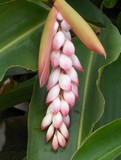
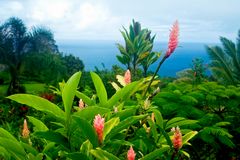 There are however some spectacular flowering gingers. If you are after great flowers get some of those. They are grown exactly like the culinary ginger, just skip the harvest :-).
There are however some spectacular flowering gingers. If you are after great flowers get some of those. They are grown exactly like the culinary ginger, just skip the harvest :-).
There's also a pretty variegated ginger, with white and green striped leaves. All the ornamental varieties are evergreen in the tropics (meaning they don't die down like the culinary ginger).
The flowers of culinary ginger are green and insignificant anyway.

 There are however some spectacular flowering gingers. If you are after great flowers get some of those. They are grown exactly like the culinary ginger, just skip the harvest :-).
There are however some spectacular flowering gingers. If you are after great flowers get some of those. They are grown exactly like the culinary ginger, just skip the harvest :-).There's also a pretty variegated ginger, with white and green striped leaves. All the ornamental varieties are evergreen in the tropics (meaning they don't die down like the culinary ginger).
Wednesday, September 8, 2010
ginger information
to know more about ginger pls visit http://www.tropicalpermaculture.com/growing-ginger.html
When to harvest ginger root?
If you are growing ginger root in the garden you can start stealing little bits of it once it is about four months old. Just dig carefully at the side of a clump. (This "green ginger" does have a lot less flavour than the mature stuff, though.)
The best time to harvest ginger is any time after the leaves have died down. Usually it takes eight to ten months to get to that point.
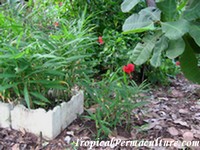 You can now dig up the whole plant. The reason that I grow my ginger in tubs is that it makes the harvest so easy. I don't have to dig, I just tip out the whole thing.
You can now dig up the whole plant. The reason that I grow my ginger in tubs is that it makes the harvest so easy. I don't have to dig, I just tip out the whole thing.
Break up the rhizomes, select a few nice ones with good growing buds for replanting (you can replant them straight away), and keep the rest for the kitchen. (I simply peel, chop and freeze the whole lot.)
The rhizomes that have been replanted or left in the ground don't need any water or attention until the weather warms up again. Mine still get watered where they are, and that doesn't seem to hurt them either.
The other way to grow and harvest ginger is to have many clumps growing around your place, and to just dig up what you need, when you need it. The plants grow outwards from the mature rhizomes. Once a clump is big enough you can harvest the mature tubers without damaging new shoots.
By the way, if you are serious about growing ginger at home then resist the urge to harvest it for a year or two. Rather build up a good resource stock first. I started with one little rhizome and dug it up the first time after two years. I replanted every single promising looking bud and still had some to eat. Next year I did the same, and after that I harvested enough to last me a year.
enjoy and learn about ginger
The best time to harvest ginger is any time after the leaves have died down. Usually it takes eight to ten months to get to that point.
 You can now dig up the whole plant. The reason that I grow my ginger in tubs is that it makes the harvest so easy. I don't have to dig, I just tip out the whole thing.
You can now dig up the whole plant. The reason that I grow my ginger in tubs is that it makes the harvest so easy. I don't have to dig, I just tip out the whole thing.Break up the rhizomes, select a few nice ones with good growing buds for replanting (you can replant them straight away), and keep the rest for the kitchen. (I simply peel, chop and freeze the whole lot.)
The rhizomes that have been replanted or left in the ground don't need any water or attention until the weather warms up again. Mine still get watered where they are, and that doesn't seem to hurt them either.
The other way to grow and harvest ginger is to have many clumps growing around your place, and to just dig up what you need, when you need it. The plants grow outwards from the mature rhizomes. Once a clump is big enough you can harvest the mature tubers without damaging new shoots.
By the way, if you are serious about growing ginger at home then resist the urge to harvest it for a year or two. Rather build up a good resource stock first. I started with one little rhizome and dug it up the first time after two years. I replanted every single promising looking bud and still had some to eat. Next year I did the same, and after that I harvested enough to last me a year.
enjoy and learn about ginger
How much and which plant food?
If you are growing ginger in good, rich soil it shouldn't need anything extra. I grow mine in tubs. I put in fresh compost mix every year and never add any extra fertiliser.
If you don't have good soil, or if you are growing ginger in some standard bought potting mix, then you have to feed it regularly. You will also have to feed it if you are growing ginger in an area that gets torrential summer rains (many tropical regions do). Such rains leach all the goodness from the soil.
Work in some organic slow release fertiliser at planting time. After that you can use some liquid fertiliser like seaweed extract or fish fertiliser every few weeks.
i will post next time about another information of ginger..
If you don't have good soil, or if you are growing ginger in some standard bought potting mix, then you have to feed it regularly. You will also have to feed it if you are growing ginger in an area that gets torrential summer rains (many tropical regions do). Such rains leach all the goodness from the soil.
Work in some organic slow release fertiliser at planting time. After that you can use some liquid fertiliser like seaweed extract or fish fertiliser every few weeks.
i will post next time about another information of ginger..
How much water need in ginger plant?
Ginger needs a lot of moisture while actively growing. The soil should never dry out. Don't overwater, though, because the water that drains away will take nutrients with it.
Ginger loves humidity. If you have problems with dry air then regular spraying and misting might help. Dry air can cause problems with spider mites. But that's rather a problem for people who try to grow ginger out of its range and indoors. A sheltered, moist spot in a warm climate will provide enough humidity.
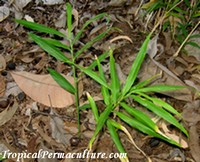 If you are growing ginger in the ground mulch it thickly.
If you are growing ginger in the ground mulch it thickly.
It helps to keep the ground moist, it helps feed the ginger as the mulch breaks down, and it also keeps down weeds.
(Ginger is a slow growing plant and easily overgrown by others.)
Towards the end of summer, as the weather starts cooling down, your ginger will start to die back. Reduce the water, even let the ground dry out. This encourages the ginger to form rhizomes. Once all the leaves have died down your ginger is ready for harvest.
hello my readers, i hope today you learn how much water need in ginger planting. i have many more information to share to you.... next time..
Ginger loves humidity. If you have problems with dry air then regular spraying and misting might help. Dry air can cause problems with spider mites. But that's rather a problem for people who try to grow ginger out of its range and indoors. A sheltered, moist spot in a warm climate will provide enough humidity.
 If you are growing ginger in the ground mulch it thickly.
If you are growing ginger in the ground mulch it thickly.It helps to keep the ground moist, it helps feed the ginger as the mulch breaks down, and it also keeps down weeds.
(Ginger is a slow growing plant and easily overgrown by others.)
Towards the end of summer, as the weather starts cooling down, your ginger will start to die back. Reduce the water, even let the ground dry out. This encourages the ginger to form rhizomes. Once all the leaves have died down your ginger is ready for harvest.
hello my readers, i hope today you learn how much water need in ginger planting. i have many more information to share to you.... next time..
Tuesday, September 7, 2010
How much space need in planting the ginger?
hello world .. read my blog to know the space need in planting the ginger..
i hope you learn in
my blog...enjoy reading..learning..
Growing ginger doesn't take up much room at all. Every rhizome you plant will first only grow a few leaves, in the one spot. Over time it will become a dense clump and very slowly get bigger, but only if it isn't harvested.
The rhizomes underground also don't seem to mind if they become a bit crowded.
Ginger only grows to about two to three feet in height.
A 14 inch pot easily holds three average rhizomes, a rectangular styrofoam box holds about nine to a dozen. If planting them in the ground plant them about six to eight inches apart. And if you want to plant a whole hectare order 1000 - 1500 kg :-).
so now you know how much space need in planting the ginger...
i hope you learn in
my blog...enjoy reading..learning..
Growing ginger doesn't take up much room at all. Every rhizome you plant will first only grow a few leaves, in the one spot. Over time it will become a dense clump and very slowly get bigger, but only if it isn't harvested.
The rhizomes underground also don't seem to mind if they become a bit crowded.
Ginger only grows to about two to three feet in height.
A 14 inch pot easily holds three average rhizomes, a rectangular styrofoam box holds about nine to a dozen. If planting them in the ground plant them about six to eight inches apart. And if you want to plant a whole hectare order 1000 - 1500 kg :-).
so now you know how much space need in planting the ginger...
Planting Ginger Root
this is how to planting the ginger root.. enjoy reading my blog i hope you learn.
The easiest way to get started growing ginger root is to get a few fresh rhizomes of someone who does grow ginger, at the time when the plant re-shoots anyway (early spring). Otherwise just buy some at the shops at that time.
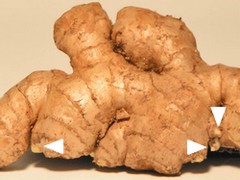 Make sure you select fresh, plump rhizomes.
Make sure you select fresh, plump rhizomes.
Look for pieces with well developed "eyes" or growth buds. (The buds look like little horns at the end of a piece or "finger")
Some people recommend to soak the rhizomes in water over night. That's not a bad idea, since shop bought ginger might have been treated with a growth retardant.
I also read the advice to sit rhizomes in water until they sprout roots. That's nonsense. Your ginger plant will be much happier if the roots are in the ground and can breathe right from the start, rather than having to deal with the transplanting shock and the change in conditions. If the ground is moist and warm they will root very easily.
Whether you grow your ginger root in a pot or in the ground, you do need really good soil to start with. It needs to be rich enough to feed your ginger (you can always add some fertiliser, see below), it needs to hold enough moisture so it doesn't dry out, but it needs to be free draining so the ginger roots don't become water logged.
Good compost is of course ideal. I use a mix of one part of my best compost with one part of my sandy garden soil. The compost supplies the nutrition and holds water, and the sand/loam makes sure the mix drains freely.
If your garden has reasonable soil just dig in some compost and that should be good enough. If your soil is too heavy you can make a raised bed or a small hill or ridge to improve drainage.
The best planting time is late winter/early spring (late dry season/early wet season, in the true tropics). Make sure you select a spot where the plants get plenty of light but no direct sun, and where they are protected from wind.
You can cut or break up the ginger rhizomes in little pieces with a couple of growing buds each. Or just plant the whole thing. Plant your ginger root five to ten centimetres deep, with the growing buds facing up.
next time i will post how the area is need in planting the ginger....
The easiest way to get started growing ginger root is to get a few fresh rhizomes of someone who does grow ginger, at the time when the plant re-shoots anyway (early spring). Otherwise just buy some at the shops at that time.
 Make sure you select fresh, plump rhizomes.
Make sure you select fresh, plump rhizomes.Look for pieces with well developed "eyes" or growth buds. (The buds look like little horns at the end of a piece or "finger")
Some people recommend to soak the rhizomes in water over night. That's not a bad idea, since shop bought ginger might have been treated with a growth retardant.
I also read the advice to sit rhizomes in water until they sprout roots. That's nonsense. Your ginger plant will be much happier if the roots are in the ground and can breathe right from the start, rather than having to deal with the transplanting shock and the change in conditions. If the ground is moist and warm they will root very easily.
Whether you grow your ginger root in a pot or in the ground, you do need really good soil to start with. It needs to be rich enough to feed your ginger (you can always add some fertiliser, see below), it needs to hold enough moisture so it doesn't dry out, but it needs to be free draining so the ginger roots don't become water logged.
Good compost is of course ideal. I use a mix of one part of my best compost with one part of my sandy garden soil. The compost supplies the nutrition and holds water, and the sand/loam makes sure the mix drains freely.
If your garden has reasonable soil just dig in some compost and that should be good enough. If your soil is too heavy you can make a raised bed or a small hill or ridge to improve drainage.
The best planting time is late winter/early spring (late dry season/early wet season, in the true tropics). Make sure you select a spot where the plants get plenty of light but no direct sun, and where they are protected from wind.
You can cut or break up the ginger rhizomes in little pieces with a couple of growing buds each. Or just plant the whole thing. Plant your ginger root five to ten centimetres deep, with the growing buds facing up.
next time i will post how the area is need in planting the ginger....
What ginger plants like and dislike
Ginger loves a sheltered spot, filtered sunlight, warm weather, humidity, and rich, moist soil. (What else did you expect from a tropical plant?)
What ginger can't stand is frost, direct sun, strong winds, and soggy, waterlogged soil.
What ginger can't stand is frost, direct sun, strong winds, and soggy, waterlogged soil.
Monday, September 6, 2010
Growing Ginger Root Is Not That Hard...
Let's first look at some pictures of ginger plants and the roots: learn and enjoy reading and viewing my blog.
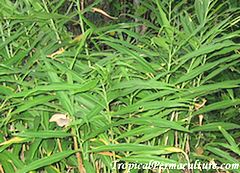
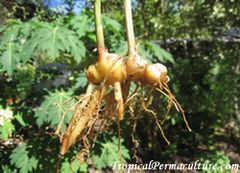 The picture on the left shows the foliage of ginger plants. On the right you see a rhizome.
The picture on the left shows the foliage of ginger plants. On the right you see a rhizome.
To talk about ginger root when talking about the edible part of the ginger plant is actually incorrect. You eat the rhizomes, and as you can see, rhizomes have roots... Two different things...
But I'll keep talking about ginger root anyway, that's what everybody does and you know what I mean.
What ginger can't stand is frost, direct sun, strong winds, and soggy, waterlogged soil.
next time i will post how to plant ginger root.

 The picture on the left shows the foliage of ginger plants. On the right you see a rhizome.
The picture on the left shows the foliage of ginger plants. On the right you see a rhizome.To talk about ginger root when talking about the edible part of the ginger plant is actually incorrect. You eat the rhizomes, and as you can see, rhizomes have roots... Two different things...
But I'll keep talking about ginger root anyway, that's what everybody does and you know what I mean.
What ginger plants like and dislike:
Ginger loves a sheltered spot, filtered sunlight, warm weather, humidity, and rich, moist soil. (What else did you expect from a tropical plant?)What ginger can't stand is frost, direct sun, strong winds, and soggy, waterlogged soil.
next time i will post how to plant ginger root.
Learn How To Grow Ginger At Home
When I started growing ginger root I expected it to be difficult. It's not.
I've been growing ginger at home for years, and ginger would have to be a serious contender for the title "most neglected plant" in my garden.
(Which is a shame. Ginger is a beautiful and beautifully scented plant. I really should move it. One day...)
I look at my ginger plants exactly once a year, at harvest time. I harvest them, replant them, and then forget about them for another year.
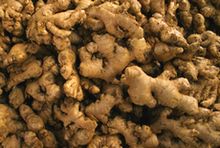 I easily grow a year's supply of ginger root from them. I also have plenty left over to give away, both ginger root planting material and ginger for eating.
I easily grow a year's supply of ginger root from them. I also have plenty left over to give away, both ginger root planting material and ginger for eating.
You can get started using store bought ginger root. And you can easily grow ginger in pots or tubs, so growing ginger indoors is a possibility in cooler climates.
On this page I tell you everything you need to know about growing ginger, so you can grow your own fresh ginger, too.
I've been growing ginger at home for years, and ginger would have to be a serious contender for the title "most neglected plant" in my garden.
(Which is a shame. Ginger is a beautiful and beautifully scented plant. I really should move it. One day...)
I look at my ginger plants exactly once a year, at harvest time. I harvest them, replant them, and then forget about them for another year.
 I easily grow a year's supply of ginger root from them. I also have plenty left over to give away, both ginger root planting material and ginger for eating.
I easily grow a year's supply of ginger root from them. I also have plenty left over to give away, both ginger root planting material and ginger for eating.You can get started using store bought ginger root. And you can easily grow ginger in pots or tubs, so growing ginger indoors is a possibility in cooler climates.
On this page I tell you everything you need to know about growing ginger, so you can grow your own fresh ginger, too.
Ginger
GINGERHindi kumpleto ang tinola, Pinakbet, escabeche't batchoy kung walang luya. And these are only a few of the many Filipino dishes which generously use "luya" as a Major food spice.6 na Uri ng LUYA NativeTIPS SA PAGTATANIM NG LUYA
| |
| Instant Ginger Tea Sangkap: 1 kilong luya (buo)Paraan ng Paggawa:
| |
Candied Ginger
|
CRYSTALLIZED GINGER
This is also type of ginger. read my blog to learn more about ginger ,...
CRYSTALLIZED GINGER: Slow-cooked in sugar water, then rolled in granulated sugar, candied ginger is a treat with a gentle, warming bite. It's also one of the world's oldest candies, and turns up in Marco Polo's descriptions of Chinese street food. Western diners, from medieval England to colonial America, nibbled slices of candied ginger after meals as both dessert and digestif.
I hope you learn and enjoy reading my blog
CRYSTALLIZED GINGER: Slow-cooked in sugar water, then rolled in granulated sugar, candied ginger is a treat with a gentle, warming bite. It's also one of the world's oldest candies, and turns up in Marco Polo's descriptions of Chinese street food. Western diners, from medieval England to colonial America, nibbled slices of candied ginger after meals as both dessert and digestif.
I hope you learn and enjoy reading my blog
Sunday, September 5, 2010
Dried Ginger
This is also a type of ginger. read my blog to learn more about ginger
DRIED GINGER: Keeping dried ginger on hand allows you to grind it only as needed¿providing surprisingly true ginger flavor. Buy it in an Indian or Chinese market, or dry your own: choose mature rhizomes for sharper taste, peel them if you wish, and let them bake in the sun for two weeks. To use, break into small pieces, and reduce to powder in an electric coffee grinder.
i will post another information about ginger next time. enjoy and learn more in my blog
DRIED GINGER: Keeping dried ginger on hand allows you to grind it only as needed¿providing surprisingly true ginger flavor. Buy it in an Indian or Chinese market, or dry your own: choose mature rhizomes for sharper taste, peel them if you wish, and let them bake in the sun for two weeks. To use, break into small pieces, and reduce to powder in an electric coffee grinder.
i will post another information about ginger next time. enjoy and learn more in my blog
Honey Lemon Ginger Tea
I want share to you how to make a honey lemon ginger tea. this is a recipe on how to make delicious honey lemon ginger tea.
Source: By Molly Watson
learn and apply this in your daily lives. i hope enjoy and learn in my blog...
next time i will post another information about ginger.
Feeling cold? Stuffy? Sore throat? Honey Lemon Ginger Tea will cure what ails you. The heat and the ginger warms you right up, the steam and the lemon and the ginger help clear those sinuses, and the ginger and the honey soothe that scratchy throat. I've been known to add a shot of whiskey to the mix, but I'm old school.
Prep Time: 5 minutes
Cook Time: 5 minutes
Total Time: 10 minutes
Ingredients:
- 1 Tbsp. freshly grated ginger (no need to peel it)
- 1 Tbsp. freshly squeezed lemon juice
- 1 Tbsp. honey, plus more to taste
Preparation:
- Put ginger in a tea pot or medium bowl. Pour 1 cup boiling water over it and let it steep for 3 minutes.
- Meanwhile, put lemon juice and honey in a large mug. Strain ginger tea into mug.
- Stir to dissolve honey, taste, and add more honey if you like.
Source: By Molly Watson
learn and apply this in your daily lives. i hope enjoy and learn in my blog...
next time i will post another information about ginger.
PRESERVED GINGER
This is also type of ginger. learn and enjoy reading my blog. ...
PRESERVED GINGER: Fresh ginger mellowed in sugar syrup is delicious as a spicy-sweet condiment or frozen in ice creams. Chinese preserves, like the naturally tawny and the brilliant red¿dyed gingers, are often flavored with a touch of salt and licorice. Since the 1940s, Australia's "ginger coast" in Queensland has also produced superb preserved ginger for export.
next time i will post another information about ginger.
PRESERVED GINGER: Fresh ginger mellowed in sugar syrup is delicious as a spicy-sweet condiment or frozen in ice creams. Chinese preserves, like the naturally tawny and the brilliant red¿dyed gingers, are often flavored with a touch of salt and licorice. Since the 1940s, Australia's "ginger coast" in Queensland has also produced superb preserved ginger for export.
next time i will post another information about ginger.
Saturday, September 4, 2010
Ginger Tea Recipe - How to Make Ginger Tea
By Cathy Wong, About.com Guide
Ginger tea is very easy to make. Here is a recipe for you to try.
Ginger Tea Recipe
Peel the ginger root and slice it into thin slices. Bring the water to a boil in a saucepan. Once it is boiling, add the ginger. Cover it and reduce to a simmer for 15-20 minutes. Strain the tea. Add honey and lemon to taste.
Note: Keep in mind that if you are making ginger tea as a home remedy during cold and flu season, sweeteners are not recommended.
Learn how to make a ginger.... enjoy and apply to your everyday live.
POWDERED GINGER
POWDERED GINGER: This mainstay of baking, which comes in several grades, has a character and a history of its own. India is the oldest source of this rich, warm spice; Jamaica provides the most expensive and highly prized example. Chinese ginger is nearly as good, and less costly. As with any ground spice, aroma and flavor are fragile, so buy in small quantities.
learn and enjoy reading my blogs. next time i will post another information about ginger
Ginger Tea
This is also a types of ginger.
GINGER TEA: Ginger is steeped alone in water to make a cleansing tonic "tea" in various parts of Asia, but it was also one of the first additives to Chinese tea, as early as the Tang period (A.D. 618¿907). A steaming cupful soothes the stomach and the soul.
GINGER TEA: Ginger is steeped alone in water to make a cleansing tonic "tea" in various parts of Asia, but it was also one of the first additives to Chinese tea, as early as the Tang period (A.D. 618¿907). A steaming cupful soothes the stomach and the soul.
Friday, September 3, 2010
Pickled Ginger
This is a type of ginger..
PICKLED GINGER: This familiar accompaniment to sushi¿known as gari in the specialized vocabulary of sushi restaurants¿is made from fresh ginger, marinated until tender and pink in a rice-vinegar brine and then sliced paper-thin along the grain. It is served both to cleanse the palate and to complement the flavor of fresh raw fish and vinegared rice.
see and learn about pickled gnger
PICKLED GINGER: This familiar accompaniment to sushi¿known as gari in the specialized vocabulary of sushi restaurants¿is made from fresh ginger, marinated until tender and pink in a rice-vinegar brine and then sliced paper-thin along the grain. It is served both to cleanse the palate and to complement the flavor of fresh raw fish and vinegared rice.
see and learn about pickled gnger
Types of Ginger
Source: Saveur
GINGER TEA: Ginger is steeped alone in water to make a cleansing tonic "tea" in various parts of Asia, but it was also one of the first additives to Chinese tea, as early as the Tang period (A.D. 618–907). A steaming cupful soothes the stomach and the soul.
POWDERED GINGER: This mainstay of baking, which comes in several grades, has a character and a history of its own. India is the oldest source of this rich, warm spice; Jamaica provides the most expensive and highly prized example. Chinese ginger is nearly as good, and less costly. As with any ground spice, aroma and flavor are fragile, so buy in small quantities.
PRESERVED GINGER: Fresh ginger mellowed in sugar syrup is delicious as a spicy-sweet condiment or frozen in ice creams. Chinese preserves, like the naturally tawny and the brilliant red–dyed gingers, are often flavored with a touch of salt and licorice. Since the 1940s, Australia's "ginger coast" in Queensland has also produced superb preserved ginger for export.
DRIED GINGER: Keeping dried ginger on hand allows you to grind it only as needed—providing surprisingly true ginger flavor. Buy it in an Indian or Chinese market, or dry your own: choose mature rhizomes for sharper taste, peel them if you wish, and let them bake in the sun for two weeks. To use, break into small pieces, and reduce to powder in an electric coffee grinder.
CRYSTALLIZED GINGER: Slow-cooked in sugar water, then rolled in granulated sugar, candied ginger is a treat with a gentle, warming bite. It's also one of the world's oldest candies, and turns up in Marco Polo's descriptions of Chinese street food. Western diners, from medieval England to colonial America, nibbled slices of candied ginger after meals as both dessert and digestif.
now you know that there are types of ginger. learn and enjoy in my blog...
next time i will post another information about ginger
Thursday, September 2, 2010
How to grow Ginger
How to Grow Ginger - Courtesy of GardenGuides.com
In order to grow ginger, make sure the environment is never lower than 40 degrees, and try to grow it in the hottest and sunniest spot available. Grow ginger, a plant with beautiful red, yellow and orange flowers, with tips from an experienced gardener
enjoy and learn how ginger grow. enjoy watching the video..
next time i will post another information about ginger
cashew ginger sauce
I hope you learn how to cooked this cashew ginger sauce....here is the recipe .....enjoy cooking
Recipe By : Cheryl 562
From: Western Mexican Cookbook
Recipe By : Cheryl 562
From: Western Mexican Cookbook
- Yield
- 1 Servings
| Measure | Ingredient | |
|---|---|---|
| 2 cups | Toasted cashew pieces | |
| 3 cups | Water or milk | |
| 2 teaspoons | Freshly grated ginger | |
| 2 teaspoons | Tamari | |
| ½ teaspoon | Salt |
Pork Dumplings with Soy-Ginger Sauce
Makes 40 t0 45 Dumplings
Ingredients
Directions
In a large bowl, combine the pork, scallions, soy sauce, sesame oil and ginger root. Mix well so that the flavors penetrate the meat. Then add the cabbage and mix until all the ingredients are thoroughly combined. The filling will not taste right if you try to combine all the ingredients at once.
Place one dumpling wrapper on a plate or a board. Place one scant tablespoon or pork mixture in the center. Moisten the edges of the wrapper with a little water, then fold them over the filling to form a half moon shape. Pinch the center together first, then stand the dumpling up on its base and pleat one of the sides of the half-moon twice, halfway between the outer edge and the center. Pleat the other side in the same way and leave the dumpling standing up.
Stand the finished dumplings on a baking sheet lined with wax paper. Do not allow the sides of the dumplings to touch each other, or they will stick together. Repeat, using the remaining dumpling wrappers and pork filling.
The dumpling can be made in advance and frozen for up to 3 months, or they can be cooked immediately, either boiled or pan-fried.
Cooking Dumplings
To Boil:
Fill a large stock pot two-thirds full of water and bring to a boil. Add one-third of the dumplings. Using a Chinese strainer or slotted spoon, stir the dumplings to prevent them from sticking together.
Return the water to a boil. The dumplings will rise to the top, but at this point, the filling will still be raw. Add 1/2 cup cold water and return to a boil again. When the dumpling floats, taste one to see if it is done. If not, add another 1/2 cup of cold water and cook until dumplings rise again. Adding cold water slows the cooking so the dough does not break, allowing enough time for the filling to be thoroughly cooked.
Pan - Fry:
Pan - fried dumplings are known as "pot stickers" because one side sticks to the bottom of the pot, becoming delightfully crisp. Heat about one tablespoon corn oil in a large nonstick skillet. Add as many dumplings as can fit in a single layer. Pour 1/2 cup cold water over the dumplings.
Cover the skillet and cook over low heat for about 10 minutes, without turning or stirring, until the water has evaporated and the dumplings are golden and crisp on the bottom.
Soy-Ginger Sauce
Ingredients
Directions
Combine all the ingredients in a small bowl. Mix thoroughly and serve. This sauce will keep for up to 1 week in the refrigerator, without the ginger root. Add the ginger root when ready to serve.
next time i post again about use of ginger
Ingredients
Directions
In a large bowl, combine the pork, scallions, soy sauce, sesame oil and ginger root. Mix well so that the flavors penetrate the meat. Then add the cabbage and mix until all the ingredients are thoroughly combined. The filling will not taste right if you try to combine all the ingredients at once.
Place one dumpling wrapper on a plate or a board. Place one scant tablespoon or pork mixture in the center. Moisten the edges of the wrapper with a little water, then fold them over the filling to form a half moon shape. Pinch the center together first, then stand the dumpling up on its base and pleat one of the sides of the half-moon twice, halfway between the outer edge and the center. Pleat the other side in the same way and leave the dumpling standing up.
Stand the finished dumplings on a baking sheet lined with wax paper. Do not allow the sides of the dumplings to touch each other, or they will stick together. Repeat, using the remaining dumpling wrappers and pork filling.
The dumpling can be made in advance and frozen for up to 3 months, or they can be cooked immediately, either boiled or pan-fried.
Cooking Dumplings
To Boil:
Fill a large stock pot two-thirds full of water and bring to a boil. Add one-third of the dumplings. Using a Chinese strainer or slotted spoon, stir the dumplings to prevent them from sticking together.
Return the water to a boil. The dumplings will rise to the top, but at this point, the filling will still be raw. Add 1/2 cup cold water and return to a boil again. When the dumpling floats, taste one to see if it is done. If not, add another 1/2 cup of cold water and cook until dumplings rise again. Adding cold water slows the cooking so the dough does not break, allowing enough time for the filling to be thoroughly cooked.
Pan - Fry:
Pan - fried dumplings are known as "pot stickers" because one side sticks to the bottom of the pot, becoming delightfully crisp. Heat about one tablespoon corn oil in a large nonstick skillet. Add as many dumplings as can fit in a single layer. Pour 1/2 cup cold water over the dumplings.
Cover the skillet and cook over low heat for about 10 minutes, without turning or stirring, until the water has evaporated and the dumplings are golden and crisp on the bottom.
Soy-Ginger Sauce
Ingredients
Directions
Combine all the ingredients in a small bowl. Mix thoroughly and serve. This sauce will keep for up to 1 week in the refrigerator, without the ginger root. Add the ginger root when ready to serve.
next time i post again about use of ginger
Wednesday, September 1, 2010
Ginger Sauce
* Exported from MasterCook *
Ginger Sauce
Recipe By :
Serving Size : 1 Preparation Time :0:00
Categories : Thai Sauces
Dips
Amount Measure Ingredient -- Preparation Method
-------- ------------ --------------------------------
1 tablespoon Garlic -- finely chopped
2 tablespoons Brown bean paste
1/4 cup Ginger -- finely chopped
1 each Serrano chili -- stemmed &
finely chopped
2 tablespoons White vinegar
1 tablespoon Sugar
1 tablespoon Soy sauce
3 each Cilantro sprigs -- chopped
Mix all ingredients thoroughly. Use immediately or at least within 6 hours of preparation as the flavours will get stronger
the longer the sauce sits.
This thick, dark, rich & spicy sauce goes well
with as a dipping sauce with bland foods such as tofu. William Crawford & Kamolmal Pootaraksa,
“Thai Home-Cooking”
Sesame Chicken Nuggets with Ginger Dressing Recipe
Developed by a famous New York City executive chef, these tasty chicken nuggets are served with a ginger dressing. Great as an appetizer or main dish. Plan at least 1 hour ahead for marinade and resting time.
Prep Time: 1 hour, 15 minutes
Cook Time: 20 minutes
Total Time: 1 hour, 35 minutes
Ingredients:
- Marinade:
- 3 large egg whites
- 1/4 cup low-sodium soy sauce
- 2 tablespoons sesame oil
- 1 teaspoon grated fresh ginger
- 1 scallion, finely chopped
- 1 pound raw chicken breast
- .
- Ginger Dressing:
- 2 tablespoons grated fresh ginger
- 1/4 cup low-sodium soy sauce
- 2 tablespoons dry (not cooking) sherry
- 1 teaspoon chopped fresh garlic
- 1 teaspoon sesame oil
- 1/2 teaspoon red chili flakes
- 2 scallions, finely chopped
- Juice of 1 lemon (about 2 tablespoons)
- Juice of 1 orange (about 1/4 cup)
- .
- Coating:
- 4 tablespoons white sesame seeds, mixed with 4 tablespoons black sesame seeds
- .
- 1/4 cup canola oil
- 1 pound fresh spinach, washed, dried, and stems removed
Preparation:
Preheat the oven to 350 degrees F.For the marinade, combine egg whites, soy sauce, sesame oil, ginger, and scallion. Whisk together until frothy. Add the chicken and marinate, refrigerated, 30 to 40 minutes.
Meanwhile, prepare the Ginger Dressing. Combine ginger, soy sauce, sherry, garlic, sesame oil, chili flakes, scallions, lemon juice, and orange juice in a saucepan and bring to a boil. Reduce the heat and simmer 5 minutes. Remove from the heat and set aside while preparing the chicken.
Cut chicken into pieces. Drain the excess liquid from the chicken and dip them in the sesame seed coating, covering them completely on all sides. Place the chicken pieces in the refrigerator about 30 minutes before cooking to allow the coating to dry.
Heat the canola oil in a heavy skillet. Saute chicken on each side until crispy on the outside. Transfer them to a cookie sheet and place in the oven 3 minutes to make sure they are fully cooked in the center.
Serve the chicken nuggets on a bed of raw spinach leaves and drizzle Ginger Dressing over the top or put in a bowl to serve on platter.
Yield: 4 servings
next time i post about ginger as souce
Cooking with ginger
pls visit a website : http://homecooking.about.com/library/archive/blmisc30.htm.
i hope you learn about ginger as recipe
i hope you learn about ginger as recipe
The History of Ginger
Ginger's current name comes from the Middle English gingivere, but ginger dates back over 3,000 years to the Sanskrit srngaveram meaning "horn root" with reference to its appearance. In Greek it was ziggiberis, and in Latin, zinziberi.
Although it was well-known to the ancient Romans, ginger nearly disappeared in Europe after the fall of the Roman Empire. Thanks to Marco Polo's trip to the Far East, ginger came back into favor in Europe, becoming not only a much-coveted spice, but also a very expensive one.
Queen Elizabeth I of England is credited with the invention of the gingerbread man, which became a popular Christmas treat.
Ginger (botanical name Zingiber officinale) is in the same family as turmeric and cardamom. It is native to Southern Asia and has long been a staple addition to Asian cuisines.
Ginger is quite popular in the Caribbean Islands, where it grows wild in lush tropical settings. Jamaican ginger is prized for its strong, perky flavor, and this island currently provides most of the world's supply, followed by India, Africa and China.
The gnarled, bumpy root of the ginger plant is the source of this wonderful spice. Although it is easily grown in tropical regions of the south, you will rarely be treated with blooms during cultivation at home the way it does normally in the wild. It can easily be grown in a flowerpot at home, but be sure to bring it indoors when the weather turns cool.
next time i want to post about the use of ginger in our food.
Although it was well-known to the ancient Romans, ginger nearly disappeared in Europe after the fall of the Roman Empire. Thanks to Marco Polo's trip to the Far East, ginger came back into favor in Europe, becoming not only a much-coveted spice, but also a very expensive one.
Queen Elizabeth I of England is credited with the invention of the gingerbread man, which became a popular Christmas treat.
Ginger (botanical name Zingiber officinale) is in the same family as turmeric and cardamom. It is native to Southern Asia and has long been a staple addition to Asian cuisines.
Ginger is quite popular in the Caribbean Islands, where it grows wild in lush tropical settings. Jamaican ginger is prized for its strong, perky flavor, and this island currently provides most of the world's supply, followed by India, Africa and China.
The gnarled, bumpy root of the ginger plant is the source of this wonderful spice. Although it is easily grown in tropical regions of the south, you will rarely be treated with blooms during cultivation at home the way it does normally in the wild. It can easily be grown in a flowerpot at home, but be sure to bring it indoors when the weather turns cool.
next time i want to post about the use of ginger in our food.
Subscribe to:
Posts (Atom)










